What Is the Ratio of Black to White Population in the Us
The Black population of the United States is growing. In 2019, there were 46.8 million people who self-identified as Blackness, making up roughly xiv% of the state'southward population. This marks a 29% increment since 2000, when there were roughly 36.2 million Black Americans.
Black Americans are diverse. This group consists of people with varied racial and ethnic identities and experiences. The nation's Black population includes those who say their race is Black, either lonely or along with other racial backgrounds. It also includes Hispanics or Latinos who say their race is Blackness.
This fact canvas is a profile of the demographic, geographic and economical characteristics of the U.S. Black population in 2019. In order to present detailed data about this grouping, charts and analysis well-nigh the Black population are analyzed through the lens of 4 different demographic groups:
- U.S. Black population (which is inclusive of the post-obit three demographic subgroups):
- Unmarried-race, not-Hispanic Black people
- Multiracial, non-Hispanic Black people
- Black Hispanic people
Scroll downward or click through the navigation bar on the left to see various demographic and economic characteristics of the U.S. Blackness population.
Click here for a downloadable spreadsheet of these findings.
The analysis presented in these fact sheets well-nigh the Blackness population in the U.s. uses the latest demographic data available. It is based on data from the U.S. Census Bureau's 2019 American Community Survey, provided through the Integrated Public Use Microdata Series (IPUMS) from the University of Minnesota.
These fact sheets rely on cocky-identification of race and ethnicity in the 2019 American Community Survey (ACS) to identify the nation'southward Blackness population. However, an private's racial and indigenous self-identification may not exist fixed and instead tin modify over time. In addition, the racial and indigenous categories used by the U.Due south. Demography Bureau can change as the way the nation sees itself changes. These changes, in turn, may impact how many people place as Black (or any other race). Encounter "What Census Calls Us" for more details on how the racial and ethnic categories have inverse throughout the years.
Unless otherwise noted, adults are those who are ages 18 and older.
U.S. Black population or total Black population refers to anyone who cocky-identifies as Black in the Us. This includes those who say their race is only Black; those who say Blackness is one of two or more races in their background; and those who say they their race is Blackness, or say that 1 of their races is Black but also indicate they are of Hispanic or Latino or Black origin. The terms Black population and Blackness people are used interchangeably in these fact sheets.
The terms single-race Black and Black lone are used interchangeably throughout these fact sheets to refer to the aforementioned population. This population is made up of individuals who self-identify only as Black and exercise not identify as Hispanic or Latino.
The term multiracial Black is used to refer to people who self-identify equally ii or more races and do non identify as Hispanic or Latino.
The term Blackness Hispanic is used to refer to those who self-identify as Black and Hispanic or Latino, also as those who self-place as multiracial Blackness and Hispanic or Latino.
Foreign born refers to persons born outside of the Us to parents neither of whom was a U.S. citizen. The terms foreign born and immigrant are used interchangeably in these fact sheets. In these fact sheets, we refer to several generations. These are defined by their nascency years and ages in 2019 as follows:
| Generation | Birth years | Age in 2019 |
|---|---|---|
| Under seven | 2012-nowadays | 0-6 |
| Generation Z (Gen Z)* | 1997-2012 | 7-22 |
| Millennial | 1981-1996 | 23-38 |
| Generation X (Gen X) | 1965-1980 | 39-54 |
| Baby Boomer (Boomer) | 1946-1964 | 55-73 |
| Silent | 1928-1945 | 74-91 |
| Greatest | Earlier 1928 | 92 and older |
Population growth
In that location were 46.8 million people in the U.S. who identified as Black in 2019. The Blackness population has grown by more than than 10 one thousand thousand since 2000, when 36.2 one thousand thousand of the U.S. population identified as Black, marking a 29% increment over virtually two decades.
More than than four.half-dozen million Black people in the U.S. were built-in outside the state as of 2019, pregnant that ten% of the Black population was foreign born. This is an increase from 2000, when 2.four million people, or roughly 7%, among the Blackness population were foreign built-in.
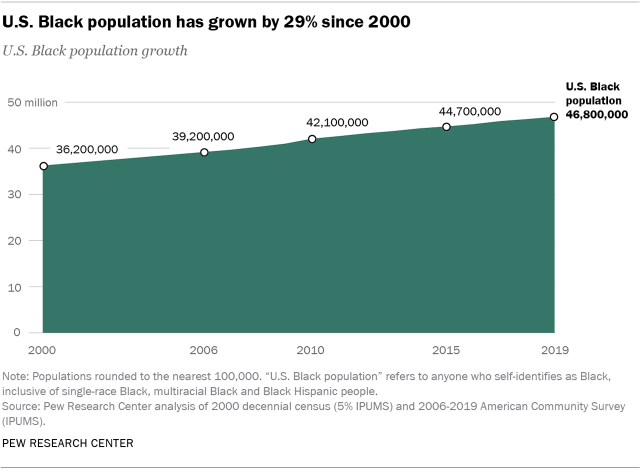
In 2019, the unmarried-race not-Hispanic Blackness population was the largest demographic subgroup of U.Due south. Blackness people, numbering 41 one thousand thousand – fully 87% of the total Black population. This marks an increment of 21% over 2000, when the population was roughly 33.7 million.
More than iv 1000000 members of this population were born outside of the U.S., meaning 10% of single-race Black people are foreign built-in. This is an increase over 2000, when ane.9 million (roughly half-dozen%) among the single-race, not-Hispanic Black population were foreign built-in.
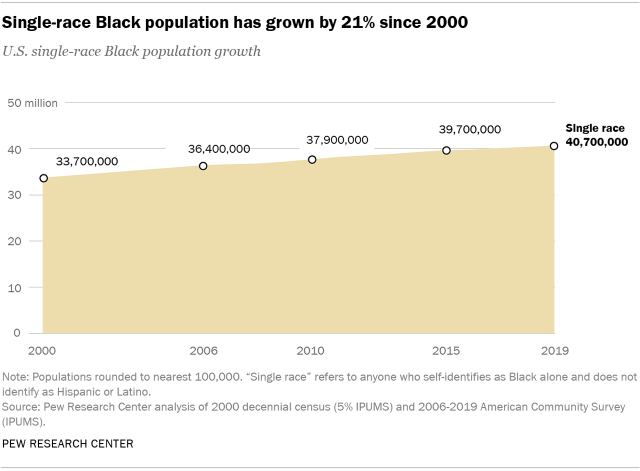
Identifying equally multiracial
It'south important to mention that in that location has been a growth in the share of people in the United States – not just Blackness Americans – who identify as multiracial in recent years. Role of this is due to expansions in how the Census Bureau asks about ethnic and racial identity. Starting in 2000, the bureau has provided respondents with the choice to identify equally more than than ane race. Besides that, younger multiracial people are more likely to identify with multiple racial or ethnic identities, on forms or otherwise.
In addition, in that location are people with multiple racial identities in their family history who do not describe themselves as multiracial. This suggests that there is probable a discrepancy between the number of multiracial Black people in the U.S., as discovered through demographic data assay, and the number of multiracial Black people who place themselves in this way.
The multiracial non-Hispanic Black population is the 2nd-largest subgroup included in this analysis, with around iii.7 million people or viii% of the overall Blackness population. Information technology has grown from roughly 1.5 million in 2000 to three.7 million in 2019, marking a 144% increment.
Additionally, 130,000 members of this population were born outside of the country, meaning that iv% of the multiracial Black population is foreign born. This is an increase from 2000, when 250,000 people, or roughly 16%, among the multiracial non-Hispanic Black population were foreign born.
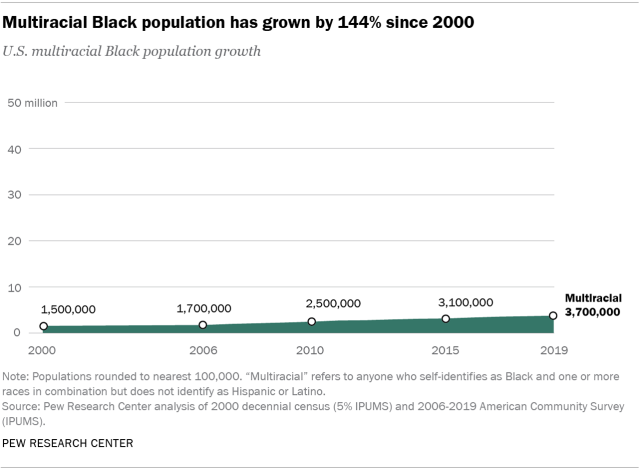
There were roughly 2.4 meg Blackness Hispanic people in the U.S. in 2019, which was 5% of the total Black population that year, making this subgroup the smallest population group included in this analysis. This population has grown from roughly one meg in 2000 to 2.4 million in 2019, marking a 145% increase.
Additionally, roughly 460,000 members of this population were born exterior of the state, meaning that almost one-in-five Blackness Hispanics (19%) are strange born. This is an increase from 2000, when roughly 260,000 people, or almost 27%, among the Blackness Hispanic population were strange born.

Age structure
The U.S. Black population is young and growing. The median age of Blackness people in 2019 was 32, vi years younger than the U.S. population's median age of 38. Roughly 30% of the entire Black population was below the age of 20 and eleven% were 65 or older.
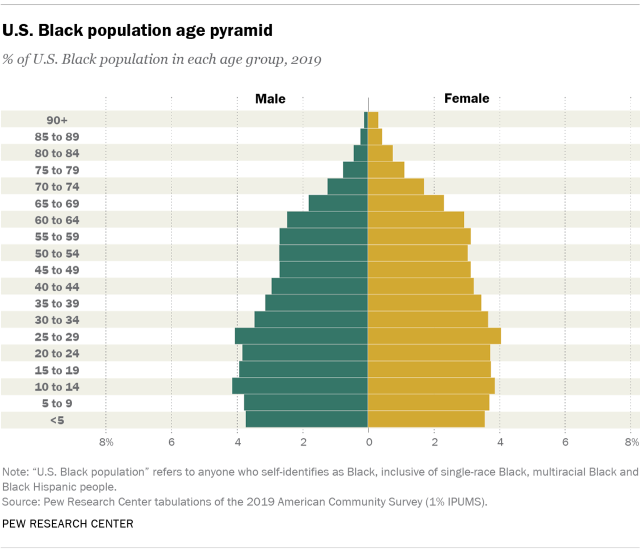
Over a third of the U.South. Black population (35%) was 22 years or younger in 2019. An boosted 23% were Millennials, significant roughly 58% of all Black Americans were age 38 or younger in 2019.
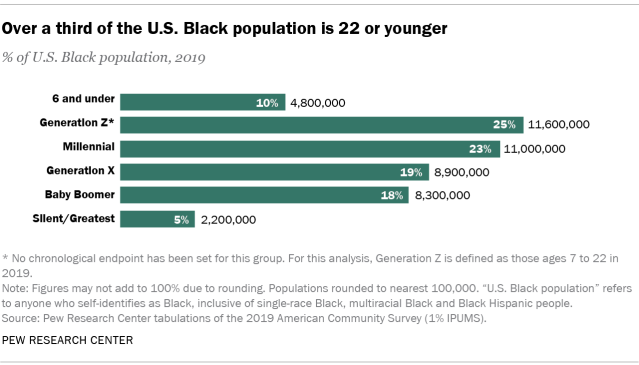
Fertility in the past year
The full general fertility rate among Black women ages 15 to 44 is 5.nine%.
The single-race Black population is young and growing. The median age of single-race Black people in 2019 was 35, three years younger than the full U.S. population's median age of 38. Roughly 27% of the single-race Blackness population were below the age of 20, and 12% were 65 or older.
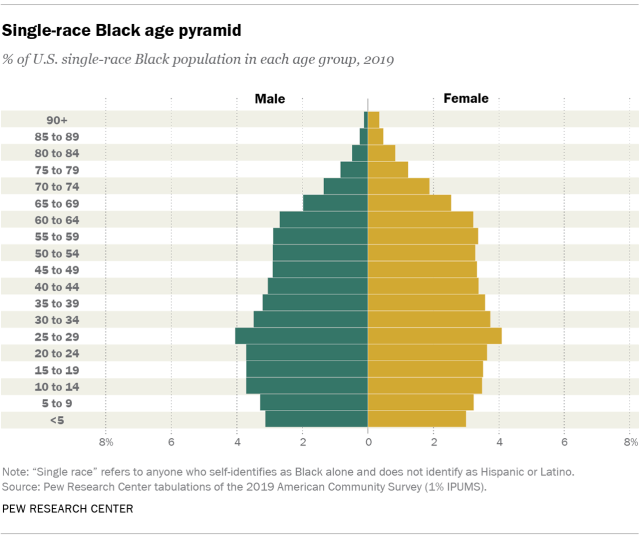
Roughly a third (32%) of the unmarried-race Black population in the U.S. were either members of Gen Z or age 6 or younger, meaning they were 22 or younger in 2019. An additional 24% were Millennials, meaning 56% of unmarried-race Black people were historic period 38 or younger in 2019.
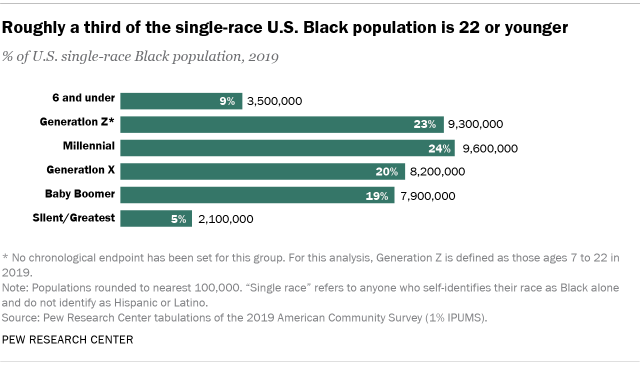
Fertility in the by twelvemonth
The fertility rate among single-race Black women in the U.S. ages xv to 44 was 6.0% in 2019.
The multiracial population pyramid shows that this population is young and growing. The median age of multiracial Black people in 2019 was xvi, making this the youngest subgroup of the Blackness population and significantly younger than the U.S. population (which had a median age of 38). Over half (57%) of the multiracial Blackness population was below the age of xx in 2019, and 3% were 65 or older.
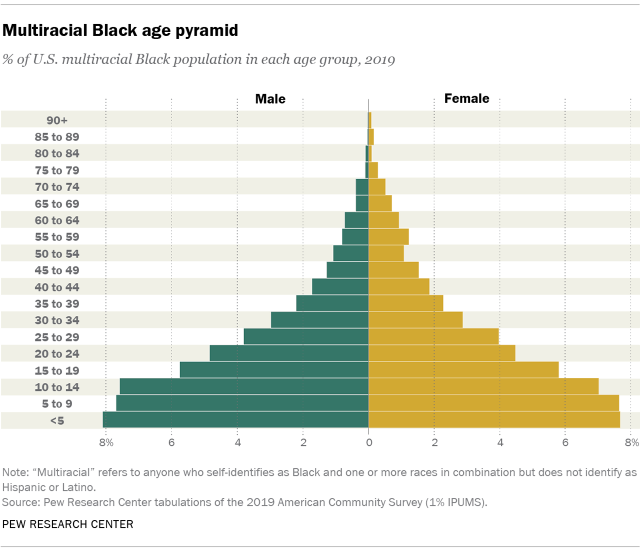
In 2019, the majority (63%) of multiracial Blackness people in the U.South. were members of Gen Z or under the age of 7, pregnant they were 22 years old or younger.
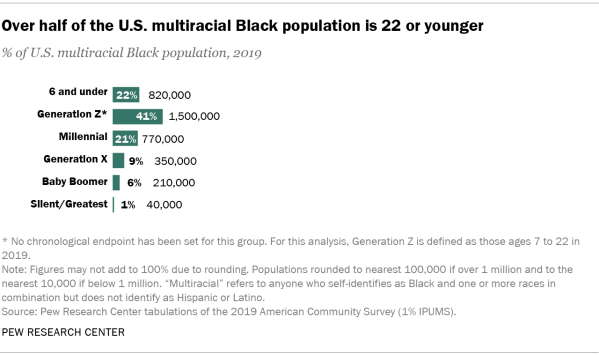
Fertility in the past yr
The fertility charge per unit among multiracial Black women in the U.S. ages 15 to 44 is 5.5%.
The total Black Hispanic population is young and growing. The median age of this population group in 2019 was 22, making Blackness Hispanics the second-youngest group included in this analysis, and notably younger than the U.South. population, which had a median age of 38.
Roughly 45% of the Black Hispanic population was below the historic period of 20, and five% were 65 or older.
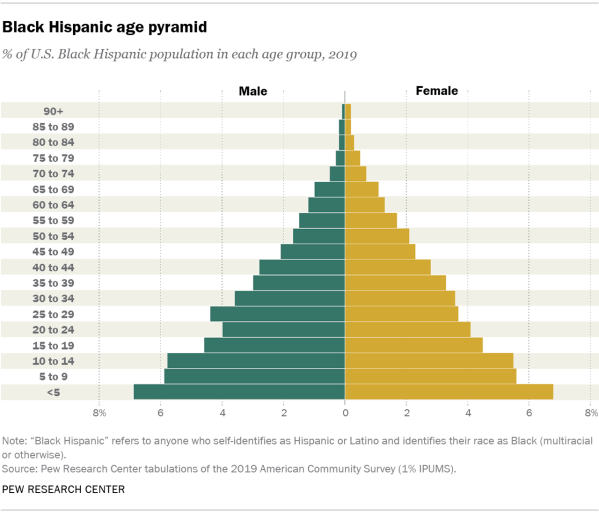
In 2019, 51% of the Black Hispanic population in the U.Due south. were members of Gen Z or under the age of 7. An additional 24% were Millennials, meaning 75% of the Black Hispanic population was 38 years of age or younger that year.
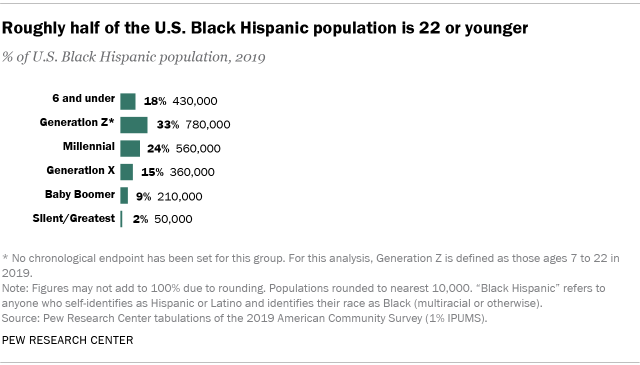
Fertility in the by yr
The fertility rate amid Black Hispanic women in the U.S. ages 15 to 44 is 5.2%.
Languages
The vast majority of the Black population equally of 2019 speaks English very well or merely speaks English at home (96%), while well-nigh nine-in-x (89%) speak only English at home. Too English language, other languages spoken by the Black population ages 5 and older include Spanish (3%), French or Haitian Creole (2%) and Amharic and other Ethiopian languages (ane%).
The vast majority of the unmarried-race Black population speaks English language very well or simply speaks English language (97%), while virtually nine-in-ten (91%) speak just English at home as of 2019. Likewise English language, other usually spoken languages past this part of the population ages 5 and older include French or Haitian Creole (2%), Spanish (1%) and Amharic and other Ethiopian languages (i%).
The vast majority of the multiracial Black population speaks English very well or but speaks English at dwelling house (99%), while about ix-in-ten (94%) speak only English at dwelling as of 2019. Spanish is spoken by ii% of the multiracial Black population in the U.s.a..
A substantial majority of the multiracial Blackness population speaks English very well or just speaks English at home (82%), while well-nigh half (48%) speak but English at home as of 2019. Likewise English, roughly half (51%) of this population speaks Spanish.
Geography
Regionally, the highest concentration of Black people in the U.S. in 2019 is in the Southward. More than one-half (56%) live in that location, while 17% live in the Midwest, 17% live in the Northeast and 10% live in the West.
When it comes to states of residence, Texas is home to the largest Black population, at about three.9 one thousand thousand. Florida comes in a shut second with three.8 million, and Georgia comes in third, with 3.6 million.
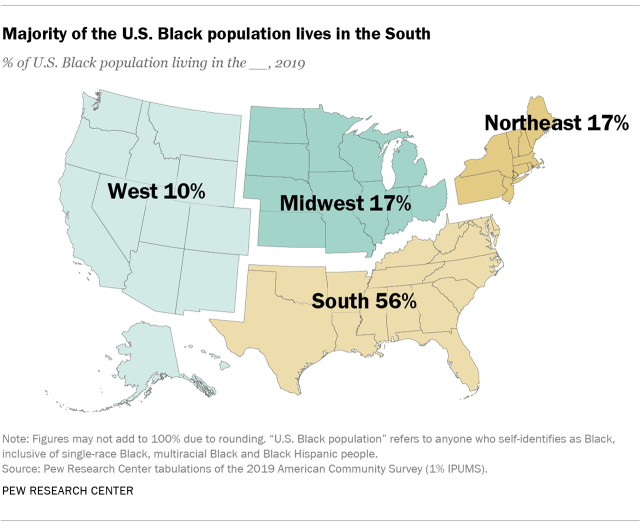
The most populous metropolitan surface area of residence for all Black people in 2019 is New York City, with three.8 million. In a distant second is Atlanta, with 2.2 million, and so the Washington, D.C., expanse, with 1.7 meg Black residents.
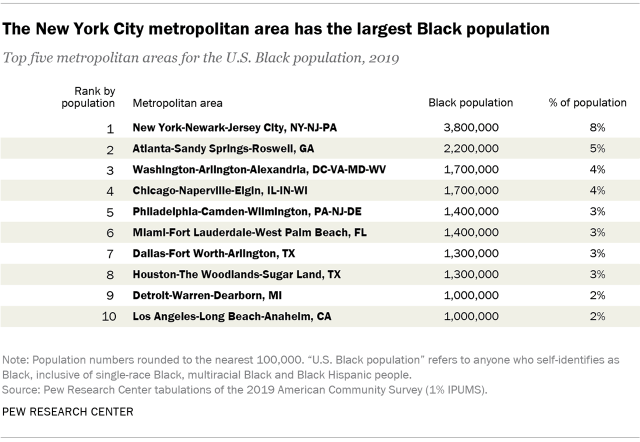
The Due south is the region with the highest concentration of the unmarried-race U.S. Black population in 2019, with a roughly six-in-10 majority (59%) of the total. The Northeast is home to 15%, another 17% live in the Midwest and ix% live in the West.
Texas is home to the largest number of Black people of any country, with around 3.iv 1000000 single-race Blackness people. Georgia and Florida are home to the next largest populations of this population, with roughly 3.iii million single-race Black people each.
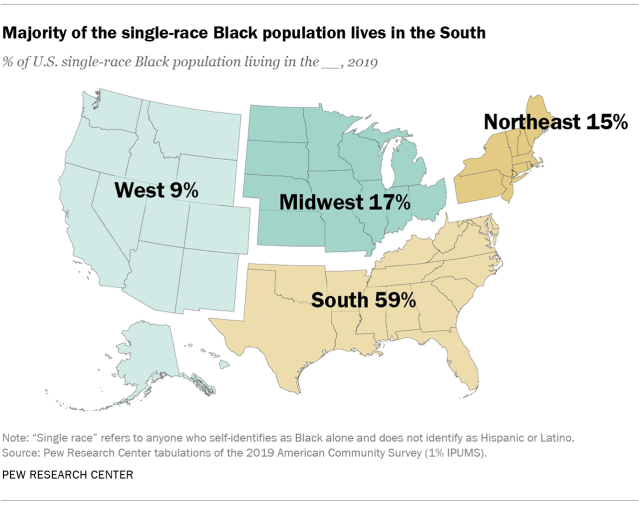
Additionally, these three states are domicile to some of the urban areas with the highest shares of single-race Black people. New York Metropolis is the metropolitan area with the largest share of the nation'southward unmarried-race Black population, with roughly 3.1 million. Other top metropolitan areas include Atlanta, Washington, D.C., Chicago and Philadelphia.
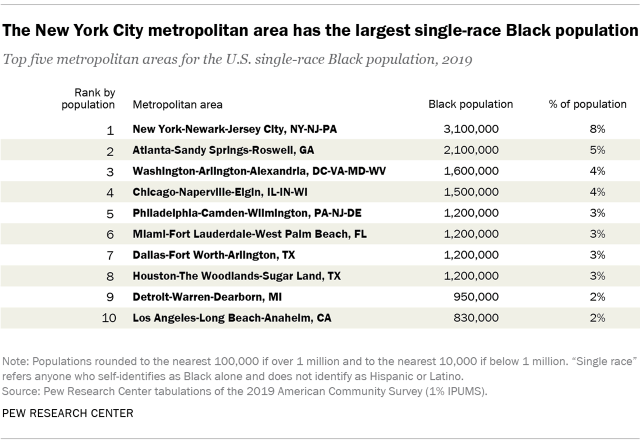
Regionally, the South is home to the highest concentration of the multiracial population in the U.South., with a plurality (40%) of the total as of 2019. Roughly a quarter (24%) live in the Midwest, ane-in-five live in the West and 16% live in the Northeast.
California is the top state of residence for multiracial Black people, with over 350,000. Texas is home to roughly 250,000 multiracial Black people, while Florida has roughly 240,000.
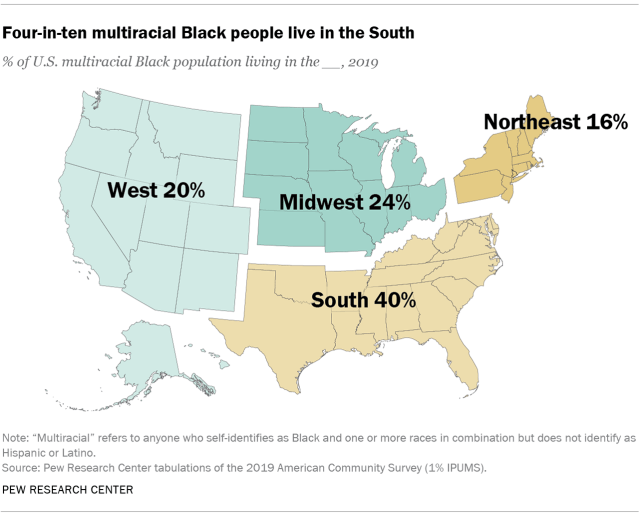
New York City is the metropolitan surface area with the highest number of multiracial Black residents and is home to roughly 160,000 members. Other top metropolitan areas for this subgroup include Washington D.C., Los Angeles and Philadelphia.
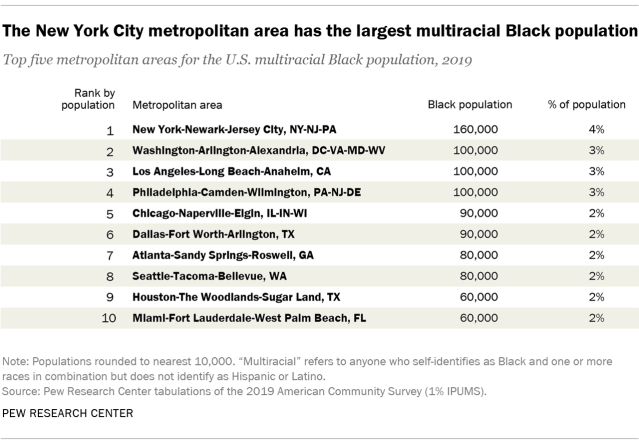
Regionally, Black Hispanic people are largely concentrated in the Northeast and South (72% in total). Fewer than ane-in-five live in the Due west (17%), and 0ne-in-ten live in the Midwest (10%) every bit of 2019. New York is the top country of residence for the Black Hispanic population, with roughly 450,000 people. Florida is domicile to the second-highest number of this population, with 260,000, and California comes in 3rd with 240,000.
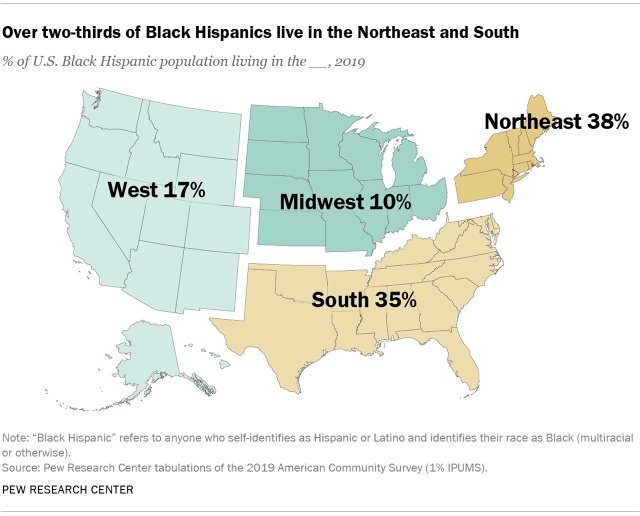
New York City is the metropolitan expanse with the largest share of the Blackness Hispanic population and is home to roughly 510,000. Other summit metropolitan areas include Miami (100,000), Boston (100,000) and Los Angeles (70,000).
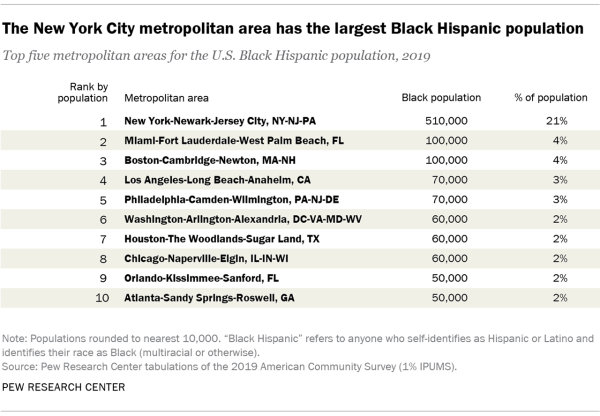
Household income
The median household income for Black households in 2019 is $44,000, which means half of households headed by a Black person earn more than that and half earn less.
Broader assay shows that more than one-half (54%) of Blackness households earn less than $l,000, while 46% make $50,000 or more. Nearly three-in-ten (28%) make $75,000 or more, including 18% that make $100,000 or more than.
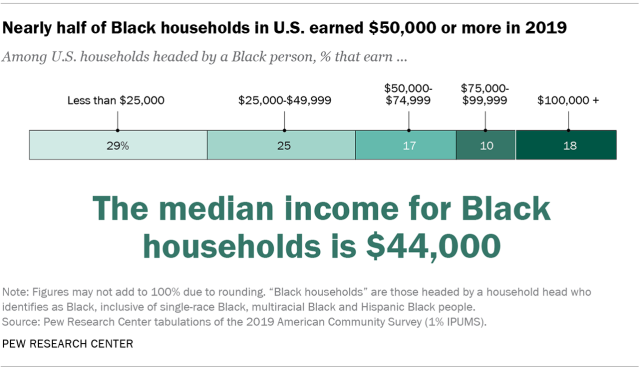
The median household income for unmarried-race Black households in 2019 is $43,200, meaning one-half of households headed past a unmarried-race Blackness person earn more than that and half earn less.
More than half of these households (55%) earn less than $50,000, with the other 44% making $50,000 or more. Within the group of households with incomes over that sum, more than a quarter (27%) brand $75,000 or more, including 17% that brand $100,000 or more than.
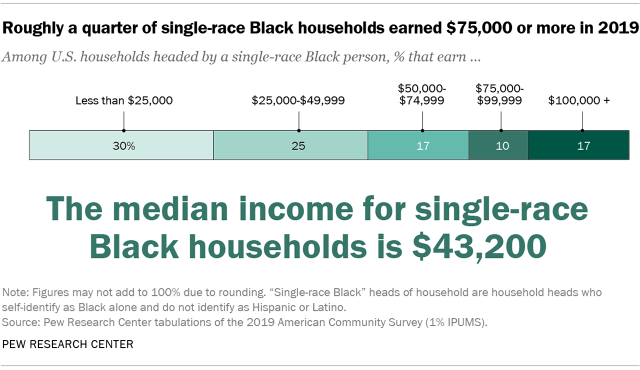
The median household income for multiracial Black households is $52,000, meaning half of Black households earn more than that and half earn less than that sum as of 2019. Looking at income some other way, nigh half of households with a multiracial Black householder (47%) make less than $50,000, and 52% brand that sum or more. Over a third (35%) make $75,000 or more, including almost a quarter (24%) that make $100,000 or more.
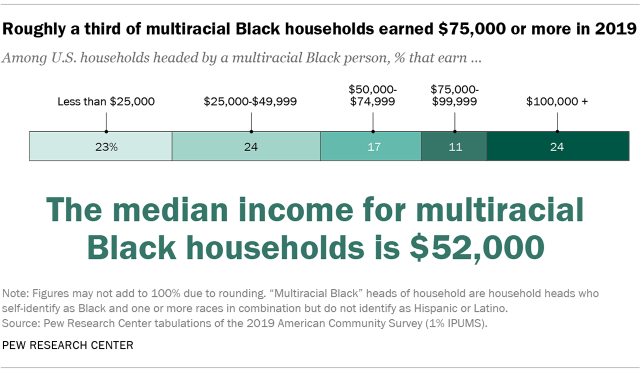
The median household income for Blackness Hispanic households is $48,900, meaning half of households with a Blackness Hispanic householder earn more than that and half earn less in 2019.
Further analysis shows that half of Black Hispanic households earn less than $50,000, while 49% make over $50,000. Roughly i-in-three of these households (32%) earn $75,000 or more, including 20% that make $100,000 or more.
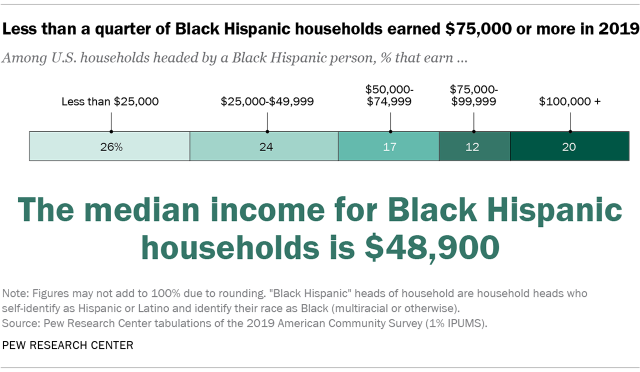
Household type
More a third (38%) of households that Black people live in are headed by married couples as of 2019. Roughly three-in-x Black people (32%) live in households whose household head is female, and 6% live in male-headed households. Fewer than a quarter (24%) are part of non-family unit households.
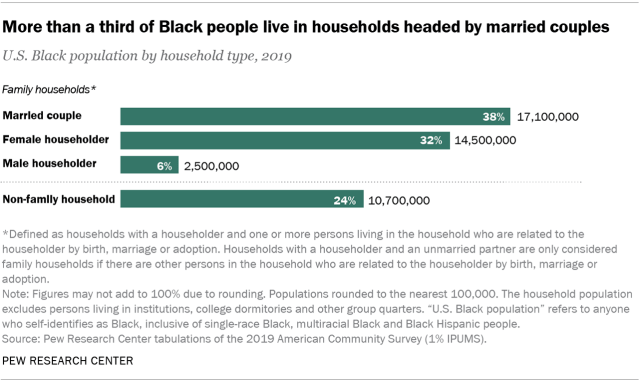
More than a third (37%) of unmarried-race Black people live in households that are headed by married couples equally of 2019. Roughly three-in-ten single-race Black people (33%) live in households with female heads of household, and 6% alive in male-headed households. Fewer than a quarter (24%) live in non-family unit households.
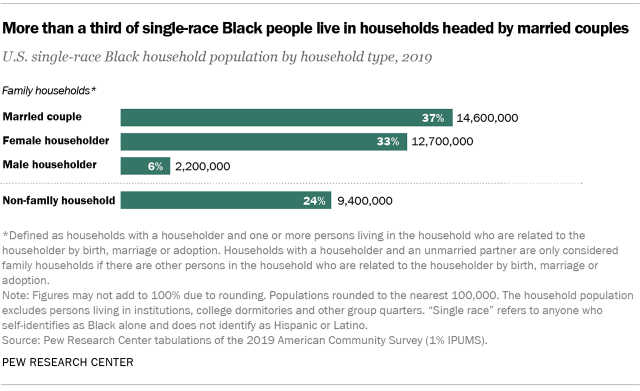
More than four-in-ten multiracial Black people (44%) live in households that are headed past married couples as of 2019. Iii-in-ten (30%) live in households whose head is female, and 5% live in male person-headed households. Additionally, roughly one-in-five multiracial Blackness people (22%) live in non-family households.

Roughly four-in-ten Black Hispanic people (42%) live in households headed past married couples in 2019. Three-in-x Black Hispanic people (30%) lived in female-headed households and 5% lived in households headed by male householders. Roughly one-in-5 Black Hispanic people lived in non-family unit households.

Educational attainment
When it comes to educational attainment, almost a quarter (23%) of all Blackness adults ages 25 and older accept a bachelor's degree or more than. A third (33%) have completed some higher as of 2019, and more than than four-in-10 (44%) have, at near, graduated from high schoolhouse (or earned an equivalent such as a GED document).
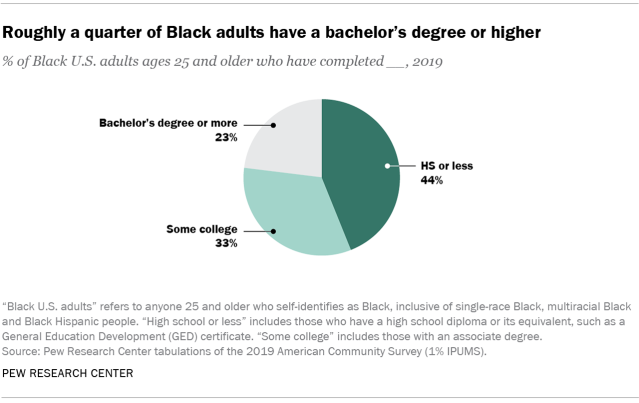
When it comes to educational attainment, roughly a quarter (23%) of unmarried-race Black adults ages 25 and older have earned a available'south caste or college every bit of 2019. A third (33%) have completed some college and 45% have, at near, graduated from high school or equivalent.
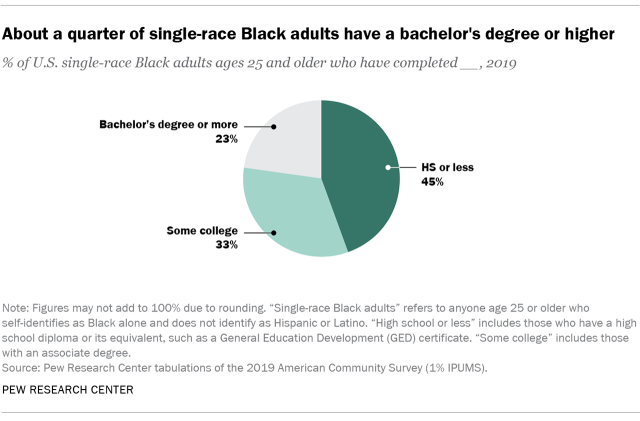
When it comes to educational attainment, almost a 3rd (32%) of multiracial Black adults ages 25 and older have earned a bachelor's degree or higher as of 2019. Near 4-in-ten (38%) have completed some college and 30% take, at well-nigh, graduated from loftier schoolhouse or its equivalent.
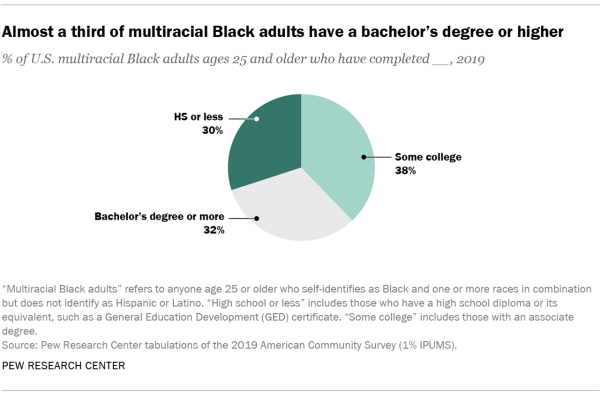
When it comes to educational attainment, near a quarter (23%) of Black Hispanic adults ages 25 and older accept earned a bachelor'south degree or higher as of 2019. Roughly a third (32%) take completed some college, and 45% take, at near, graduated from high school or equivalent.
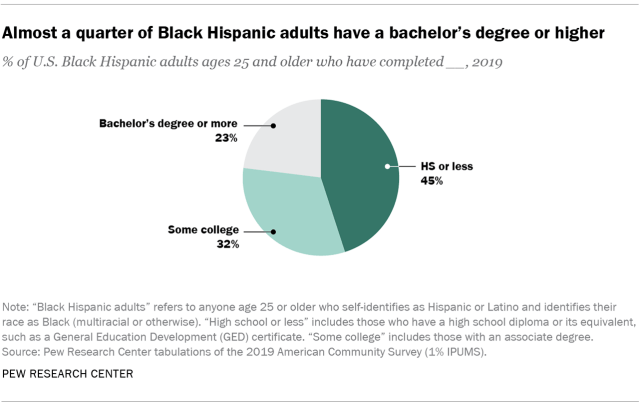
Religious affiliation
Two-thirds (66%) of all Black adults identify as Protestant. Roughly i-in-five (21%) are unaffiliated with any particular faith, while smaller shares of adults place as Cosmic (6%), other Christian denominations (3%) or non-Christian faiths (3%).
For more, read " Religion Among Black Americans "
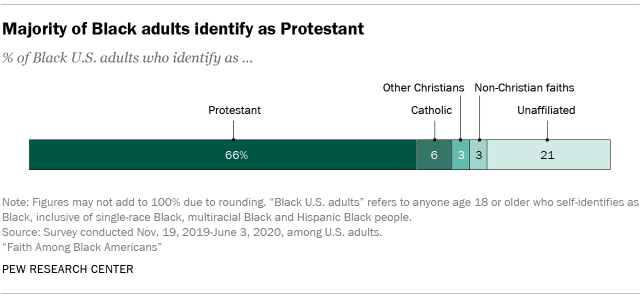
A majority (69%) of single-race Black adults identify equally Protestant. Roughly one-in-five (19%) are unaffiliated with whatever religion, while smaller shares of adults identify as Cosmic (5%), other Christian denominations (iii%) or non-Christian faiths (iii%).
For more, read " Faith Amid Black Americans "
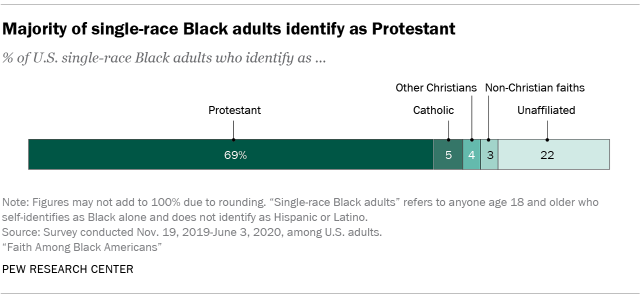
Similar shares of multiracial Black adults identify every bit Protestant (41%) or as religiously unaffiliated (38%). Smaller shares of adults within this population subgroup identify as Catholic (11%), other Christian denominations (4%) or non-Christian faiths (6%).
For more, read " Faith Among Black Americans "
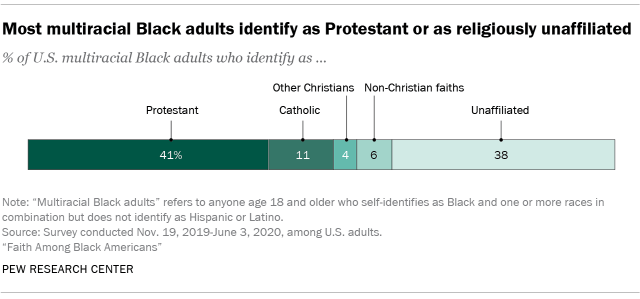
Almost half dozen-in-x Black Hispanic adults (59%) identify every bit either Protestant (35%) or Catholic (24%). A third identify every bit unaffiliated (33%), while smaller shares place every bit other Christian denominations (two%) or follow non-Christian faiths (6%).
For more, read " Faith Among Black Americans "
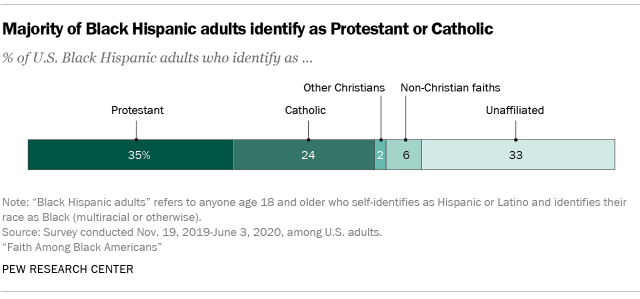
williamsackelvel60.blogspot.com
Source: https://www.pewresearch.org/social-trends/fact-sheet/facts-about-the-us-black-population/
0 Response to "What Is the Ratio of Black to White Population in the Us"
Postar um comentário